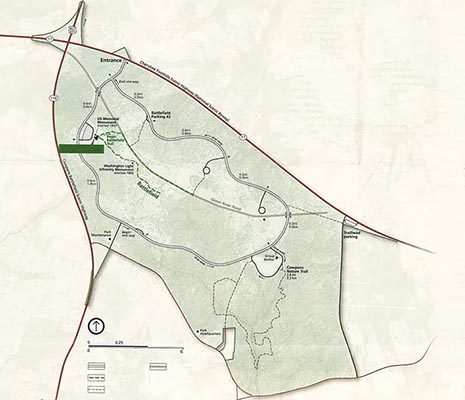Last updated: May 8, 2019
Lesson Plan
Mapping the Battle of Cowpens

- Grade Level:
- Upper Elementary: Third Grade through Fifth Grade
- Subject:
- Social Studies
- Lesson Duration:
- 90 Minutes
- Common Core Standards:
- 3.RI.7, 4.RI.9
- State Standards:
- SC 3-3.2, 3-3.3, 4-3.3, 8-2.5
- Thinking Skills:
- Understanding: Understand the main idea of material heard, viewed, or read. Interpret or summarize the ideas in own words.
Essential Question
Who were the different troops at the Battle of Cowpens and how did they work together to beat the British?
Objective
Who were the different troops at the Battle of Cowpens and how did they work together to beat the British? Students will participate in a web quest and create an interactive map of the battle that shows the placement of and information about the different troops and their leaders.
Background
The Battle of Cowpens was a turning point in the Southern Campaign of the American Revolution. General Daniel Morgan commanded a mix of troops that included regular Continentals, dragoons (cavalry), and local militias. Morgan’s unique plan for the battle used the strengths of each of the troops in order to beat the British. His understanding of the strengths (and weaknesses) of his troops allowed him to complete a double envelopment, the only time this has been accomplished on American soil.
Preparation
Computers for each group of students with internet access and presentation software (such as Power Point or Keynote)
Materials
Pretend that you have been hired by the National Park Service to create an interactive map of the Battle of Cowpens. This map will show where all of the Patriot troops were lined up for the battle, who all of the different types of troops were, and who the leaders of each group were. The NPS has asked you to create this map to help Americans who will never get to come to Cowpens to have an idea of what happened in this key battle.
Download Mapping the Battle of Cowpens Webquest
Procedure
- Make sure there are enough computers for each group of students to have one for research. Also determine how you will share the web quest (a Power Point presentation) with your students. The Power Point includes links for research.
- Assign students to small groups to work on this project. Determine whether each group will study all of the troops involved OR just one group and then work together with 2 other groups to create the map.
- Introduce the web quest using the introduction and task pages. Show the students the rubric that will be used for scoring.
- Allow time for research.
- Demonstrate how to make a presentation interactive.
- Allow time for students to create the interactive map.
- If time allows (and you wish) allow student groups to present their maps to the class.
Vocabulary
American Revolution - The American Revolution was a political upheaval that took place between 1765 and 1783 during which colonists in the Thirteen American Colonies rejected the British monarchy and aristocracy, overthrew the authority of Great Britain, and founded the United States of America.
Continental – American regular army during the Revolutionary War. These soldiers enlisted and served for long periods of time.
Dragoon - a mounted infantryman usually armed with a pistol and saber
Cavalry – part of military that serves on horseback
Militia – a body of citizen soldiers. These soldiers served for shorter periods of time and were armed with their personal weapons – usually hunting rifles and knives or tomahawks.
Musket – A large caliber smooth bore gun used by the regular soldiers on both sides.
Rifle – A gun with rifling in the bore. This allows for longer shots and greater accuracy.
Southern Campaign – Second part of the American Revolution fought in the Southern Colonies.
Assessment Materials
EvaluationA rubric is included in the Power Point for scoring the presentations.
NOTE: Teachers may wish to add scores for cooperation and teamwork and/or oral presentation to the rubric.
A rubric is included in the Power Point for scoring the presentations.
NOTE: Teachers may wish to add scores for cooperation and teamwork and/or oral presentation to the rubric.
